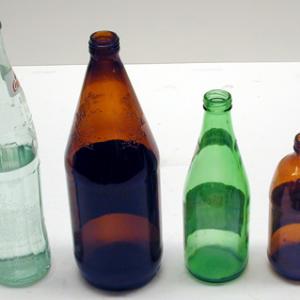College of Liberal Arts & Sciences
3C20.25 - Musical Pop Bottles
Fill the pop bottles with water to different levels and hear the different resonance frequencies. This shows the resonance of an adjustable cavity.
Pop bottles may be considered Helmholtz resonators and not closed pipe demonstrations, as the resonance depends on the column of air in the bottle.
- Alfred F. Leung, "Measuring the Thickness of a Transparent Ring with a Laser", TPT, Vol. 45, # 4, April 2007, p. 239.
- Paul Gluck, Sarit Ben-Sultan, and Tamar Dinur, "Resonance in Flasks and Pipes", TPT, Vol. 44, # 1, Jan. 2006, p. 10.
- Mark P. Silverman and Elizabeth R. Worthy, "Musical Mastery of a Coke TM Bottle: Physical Modeling by Analogy", TPT, Vol. 36, # 2, p. 70, Feb. 1998.
- Niran Charoenkul, "Easy Beats", TPT, Vol. 35, # 8, Nov. 1997, p. 490.
- H. Richard Crane, "Body Volume Measured by Sound Waves", TPT, Vol. 25, # 7, p. 454, October 1987.
- Suzanne M. Lea, Robert B. Muir, and G. T. Hageseth, Arthur B. Hunkins, "A Physics Olympics "Physics Phanfare"", TPT, Vol. 25, # 3, Mar. 1987, p. 163.
- Frank S. Crawford, "Lowest Modes of a Bottle", AJP, Vol. 56, No. 8, Aug. 1988, p. 702.
- Se- 4: Freier and Anderson, A Demonstration Handbook for Physics.
- W- 260: "Jingle Bells COKE Bottles", DICK and RAE Physics Demo Notebook.
- Tik Liem, "The Singing Bottle", Investigation to Science Inquiry, p. 301.
- Pat Murphy, Ellen Macaulay, and the staff of the Exploratorium, "Sorting Sounds", Exploratopia, p. 345.
- Pat Murphy, Ellen Macaulay, and the staff of the Exploratorium, "Bottle Band", Exploratopia, p. 217.
- Borislaw Bilash II, David Maiullo, "Good Vibrations", A Demo a Day: A Year of Physics Demonstrations, p. 216.
- "The Science of Sound", The Boy Scientist, p. 177.
- Jearl Walker, "3.41, Bottle Resonance", The Flying Circus of Physics Ed. 2, p. 163.
- 1.57, Jearl Walker, "Blowing on a Coke Bottle", The Flying Circus of Physics with Answers.
- Sara Stein, "Bottle Flute", The Science Book, p. 183.
Disclaimer: These demonstrations are provided only for illustrative use by persons affiliated with The University of Iowa and only under the direction of a trained instructor or physicist. The University of Iowa is not responsible for demonstrations performed by those using their own equipment or who choose to use this reference material for their own purpose. The demonstrations included here are within the public domain and can be found in materials contained in libraries, bookstores, and through electronic sources. Performing all or any portion of any of these demonstrations, with or without revisions not depicted here entails inherent risks. These risks include, without limitation, bodily injury (and possibly death), including risks to health that may be temporary or permanent and that may exacerbate a pre-existing medical condition; and property loss or damage. Anyone performing any part of these demonstrations, even with revisions, knowingly and voluntarily assumes all risks associated with them.
